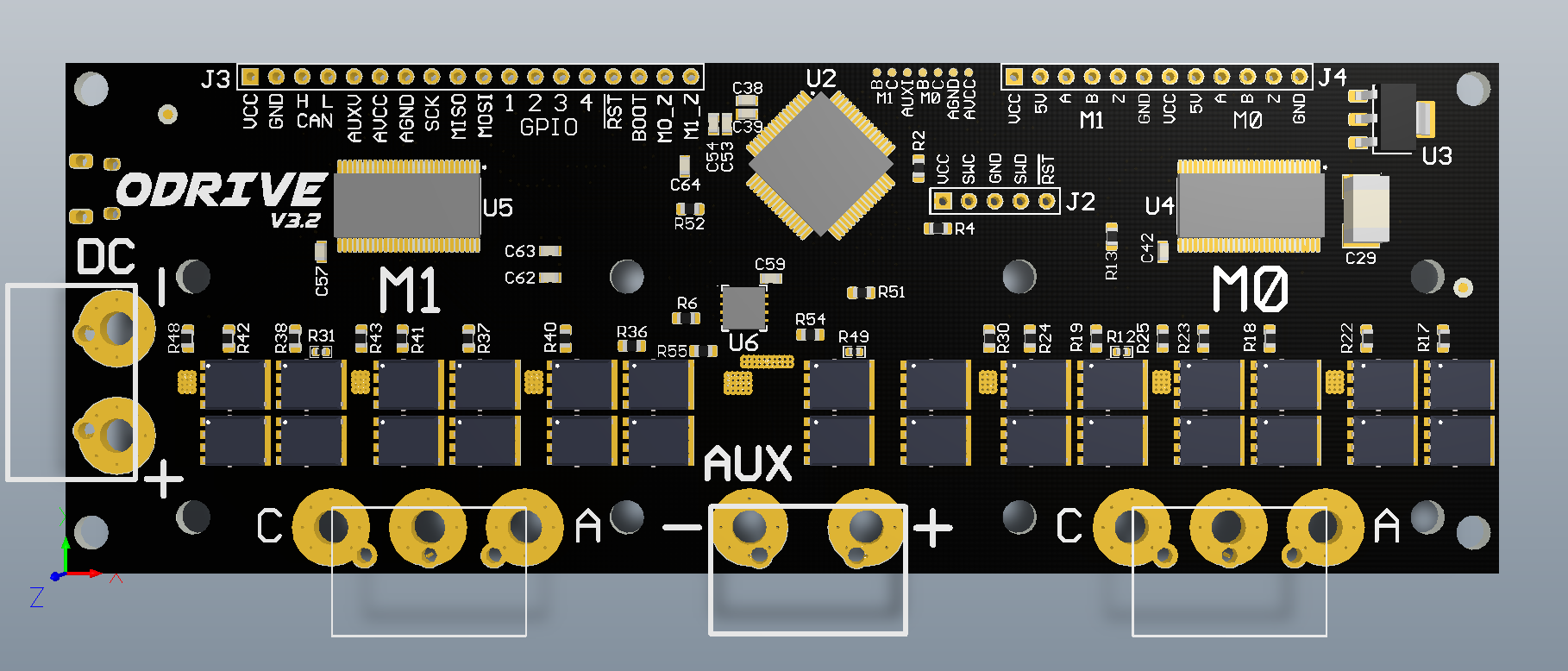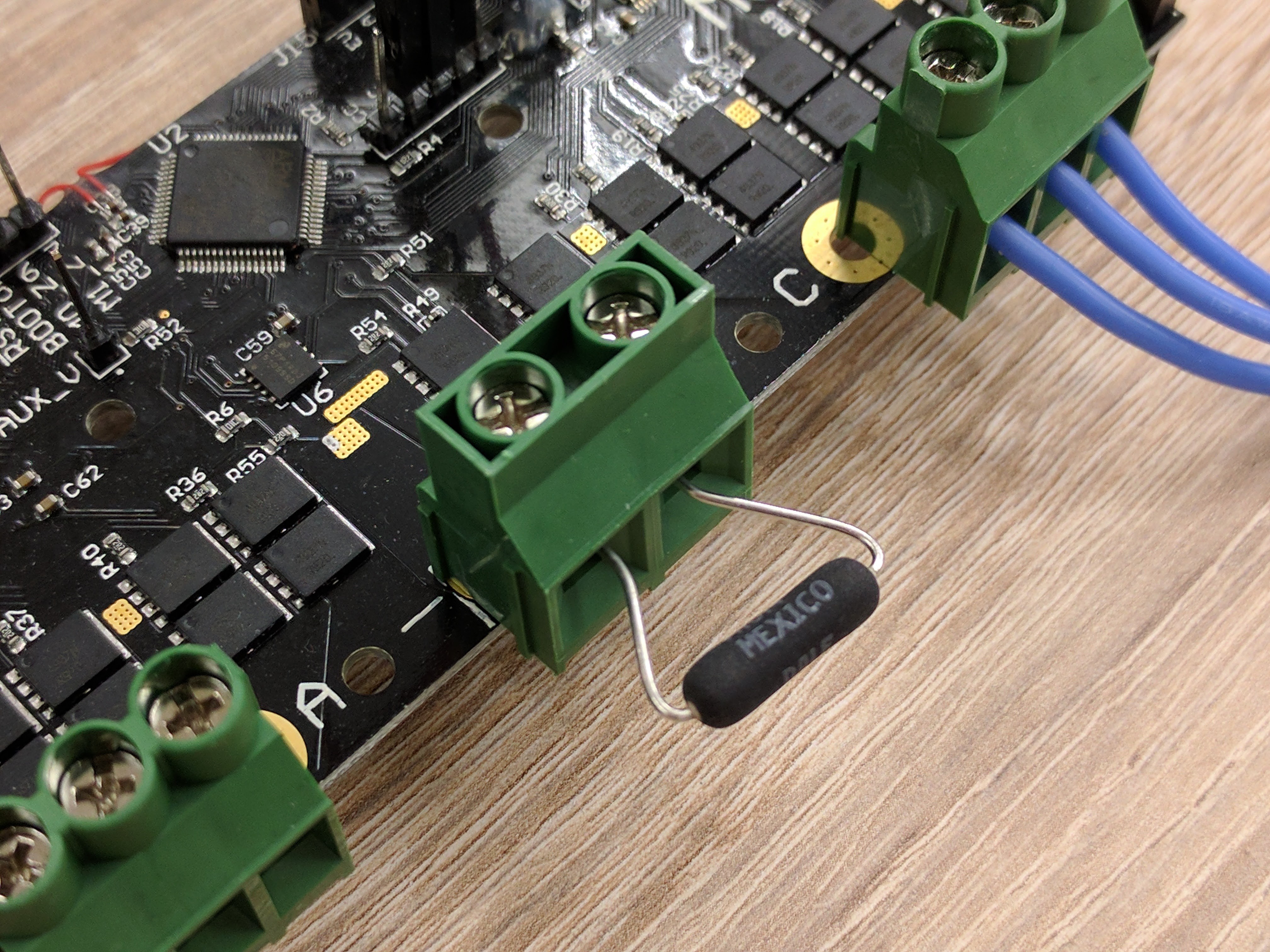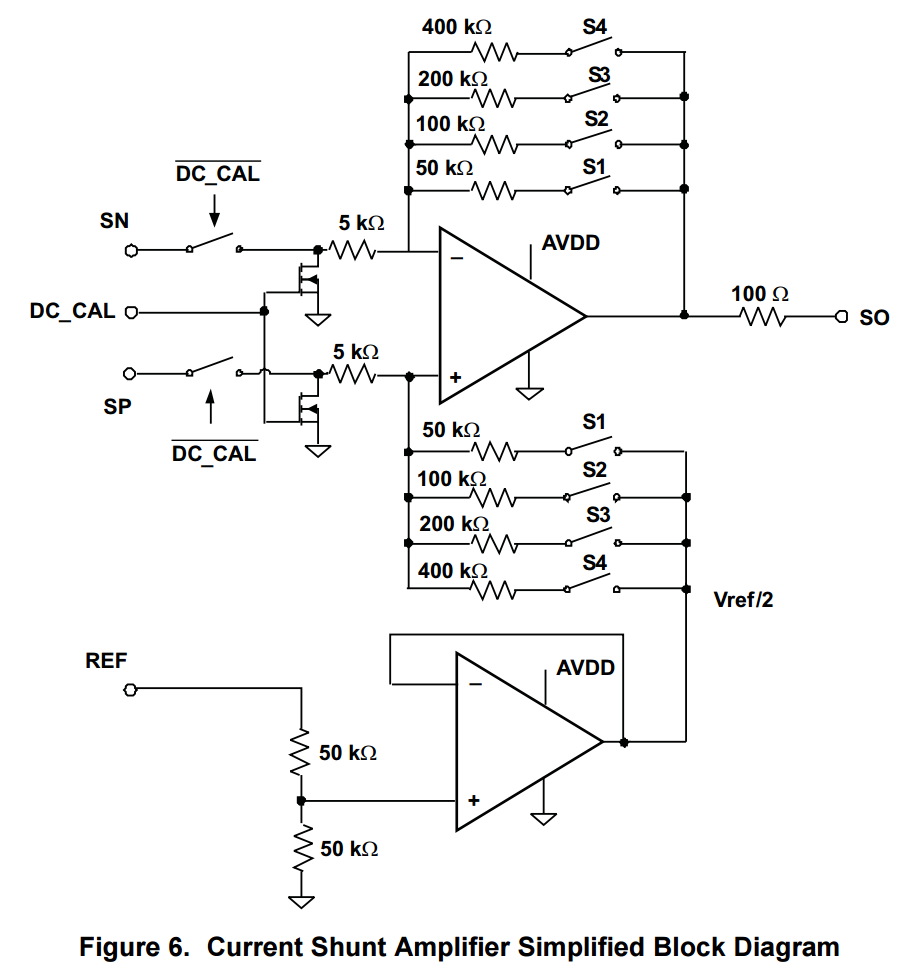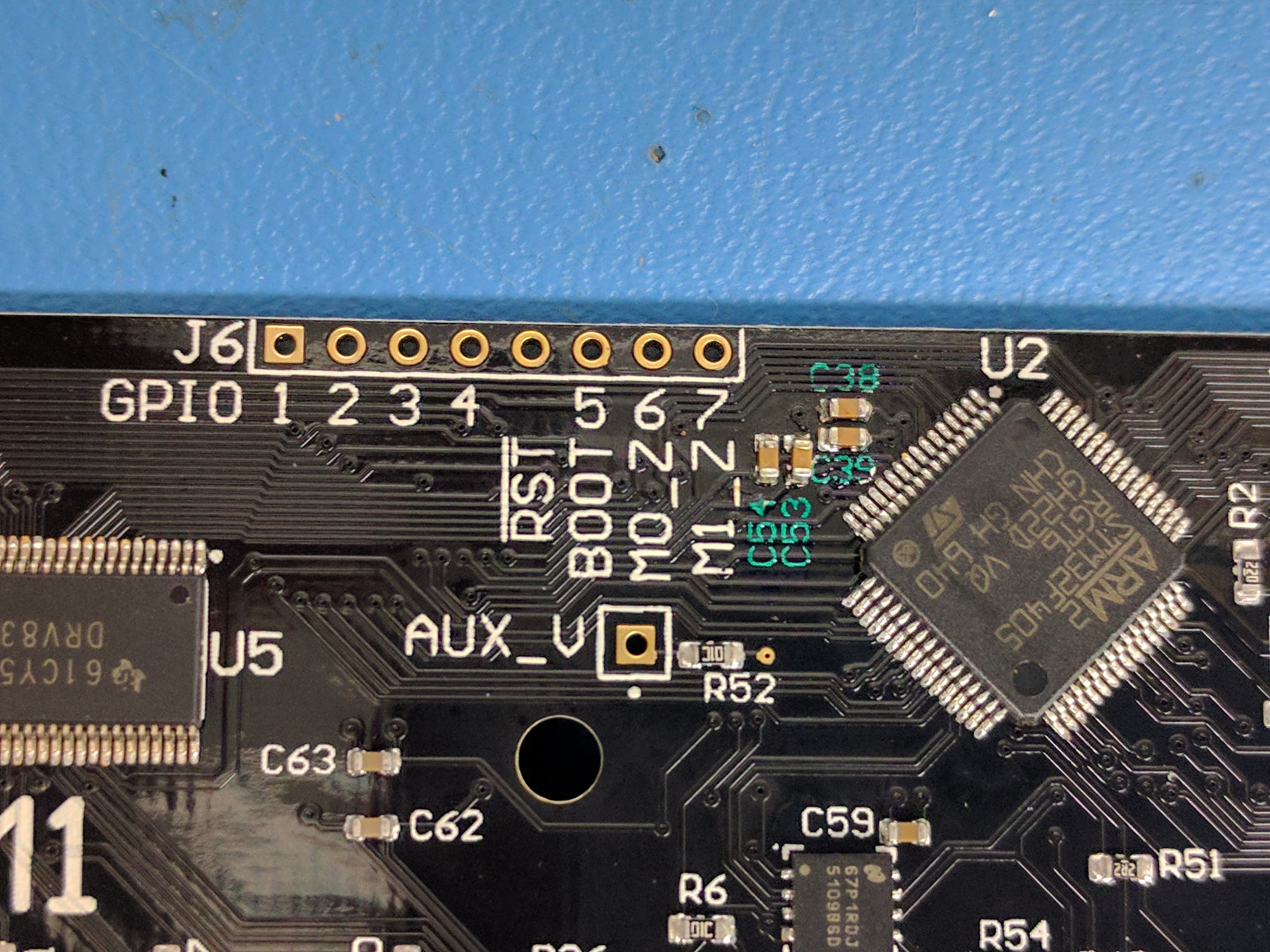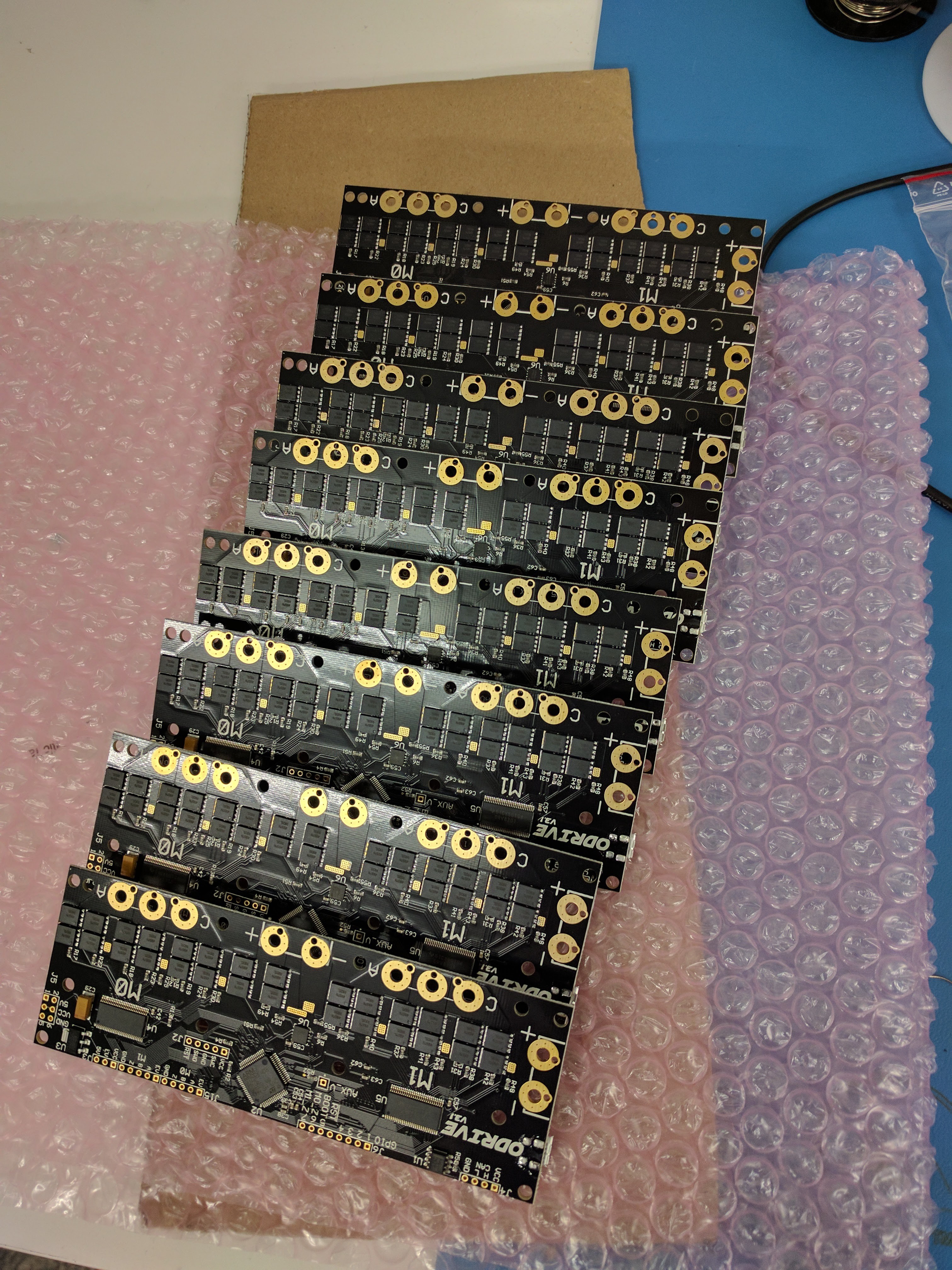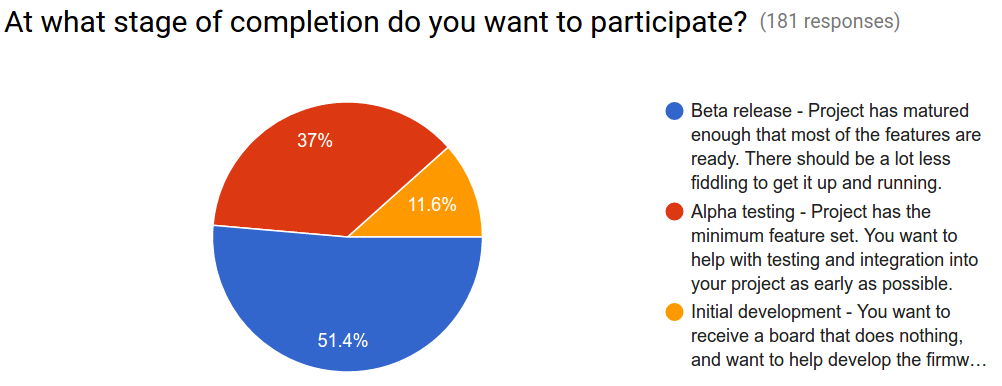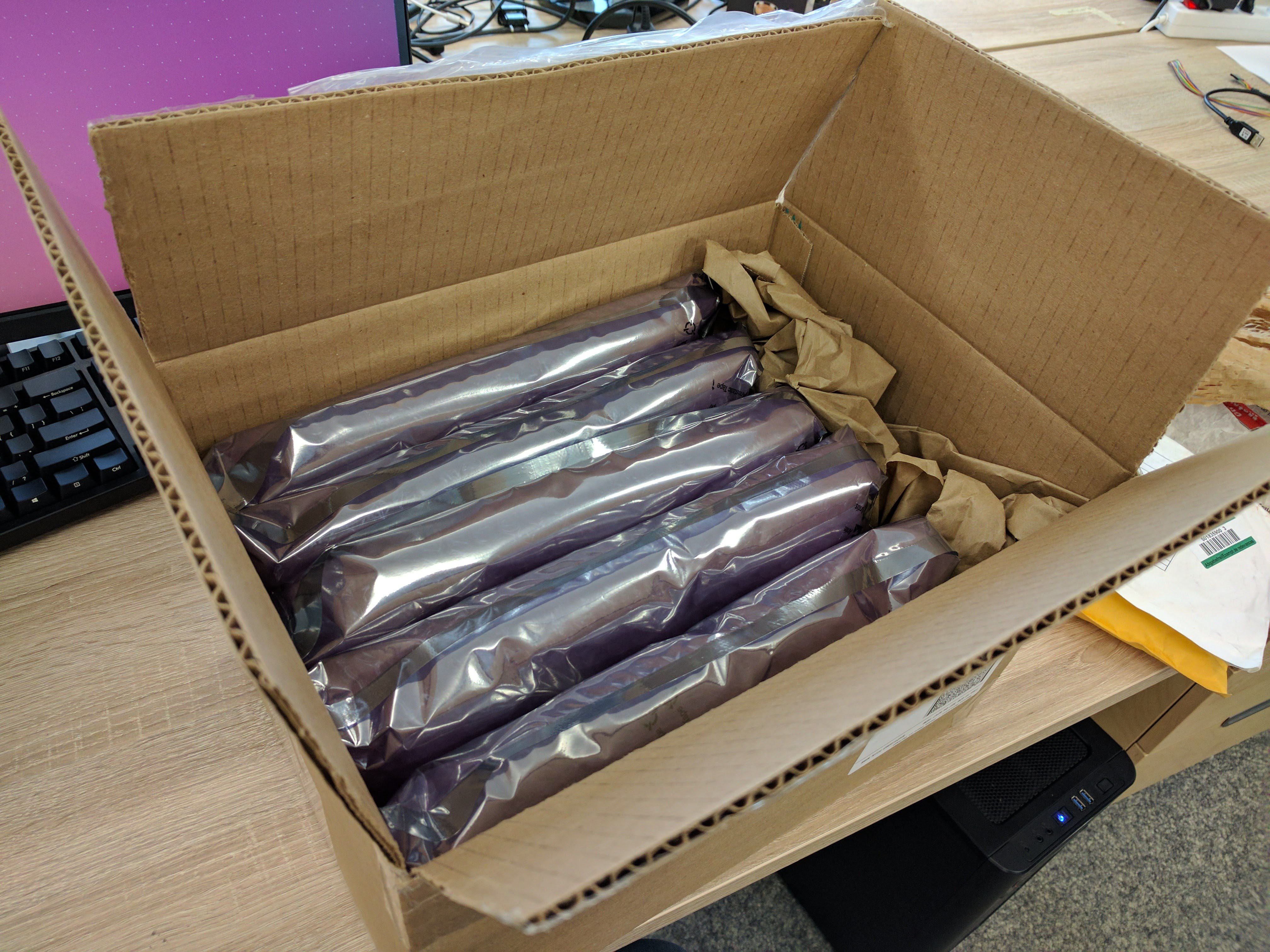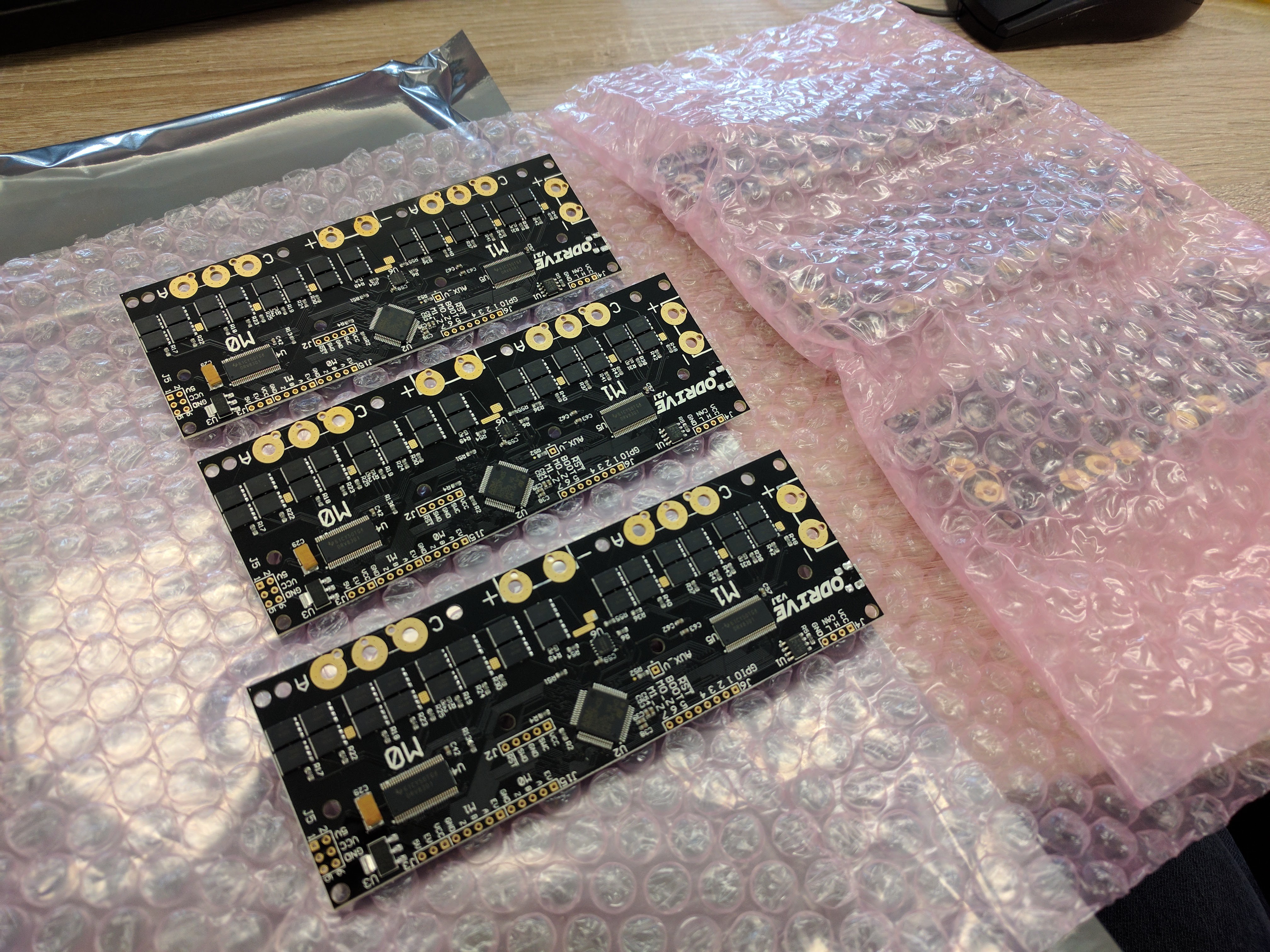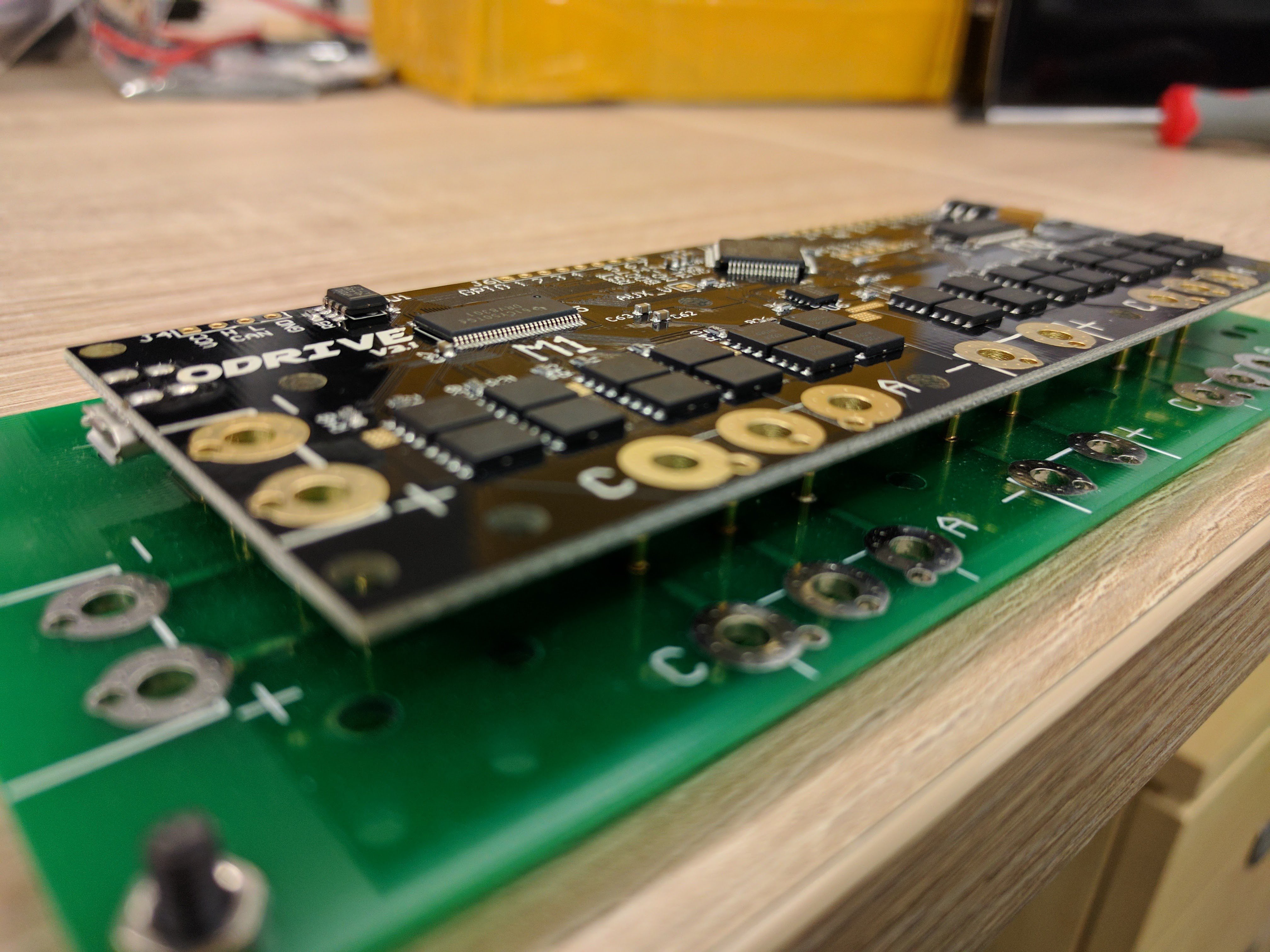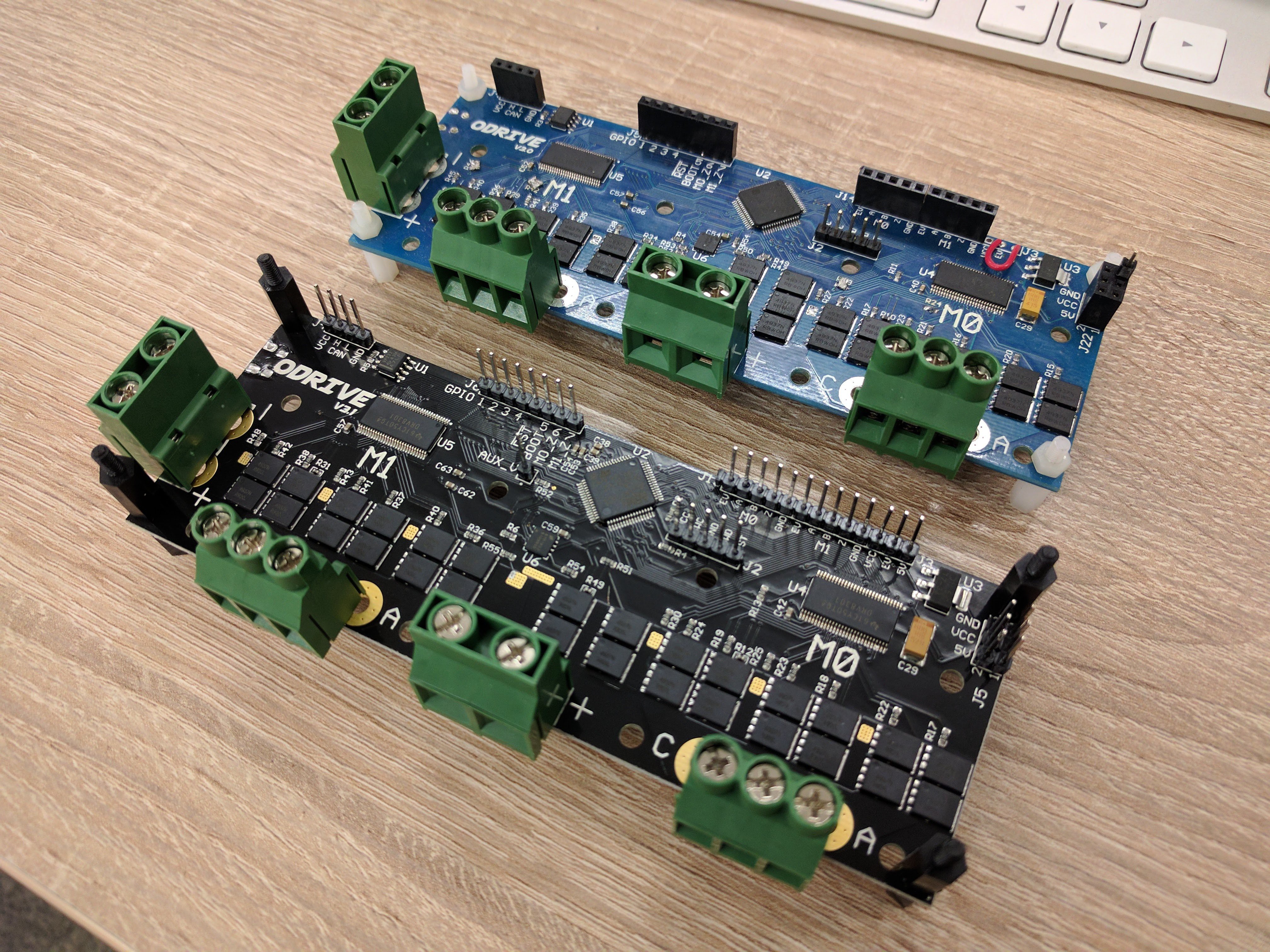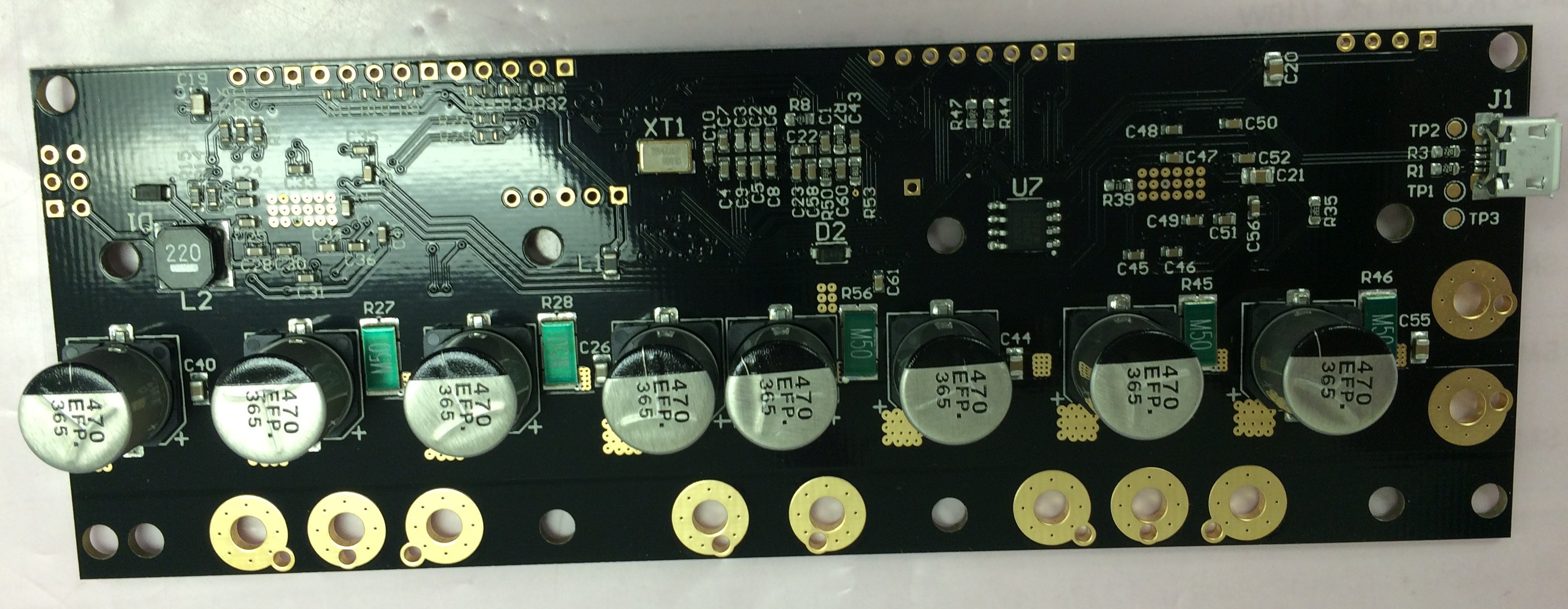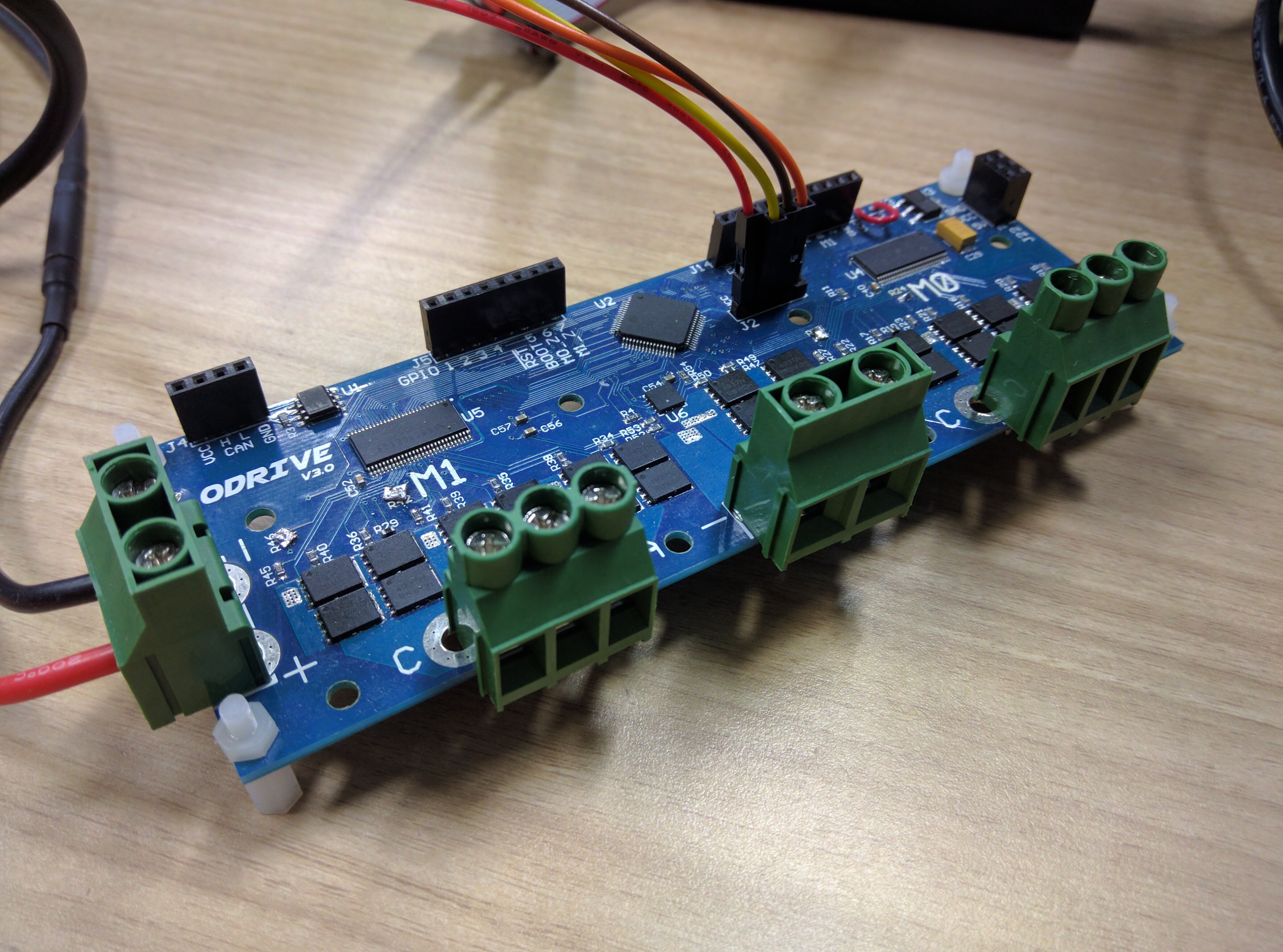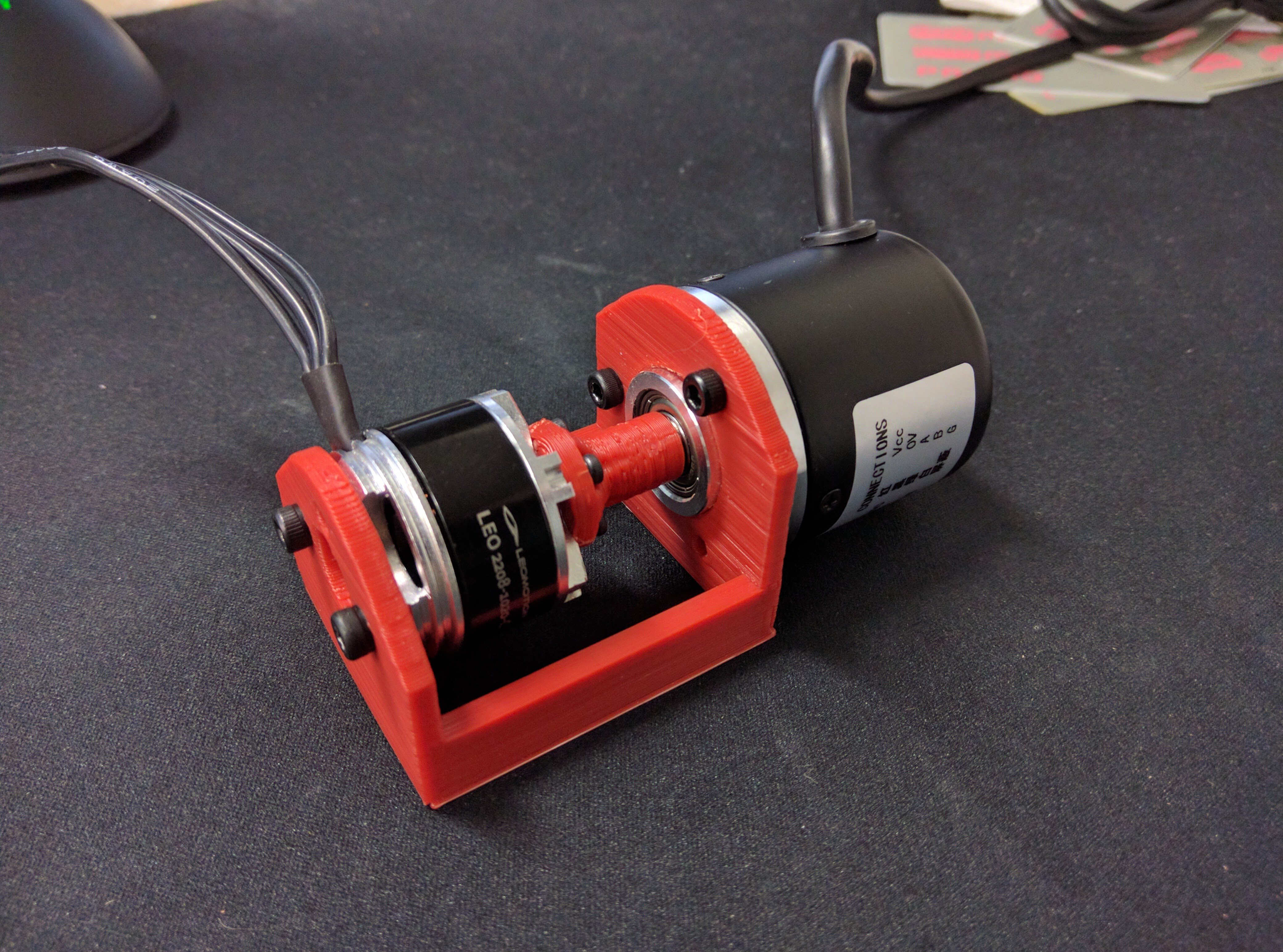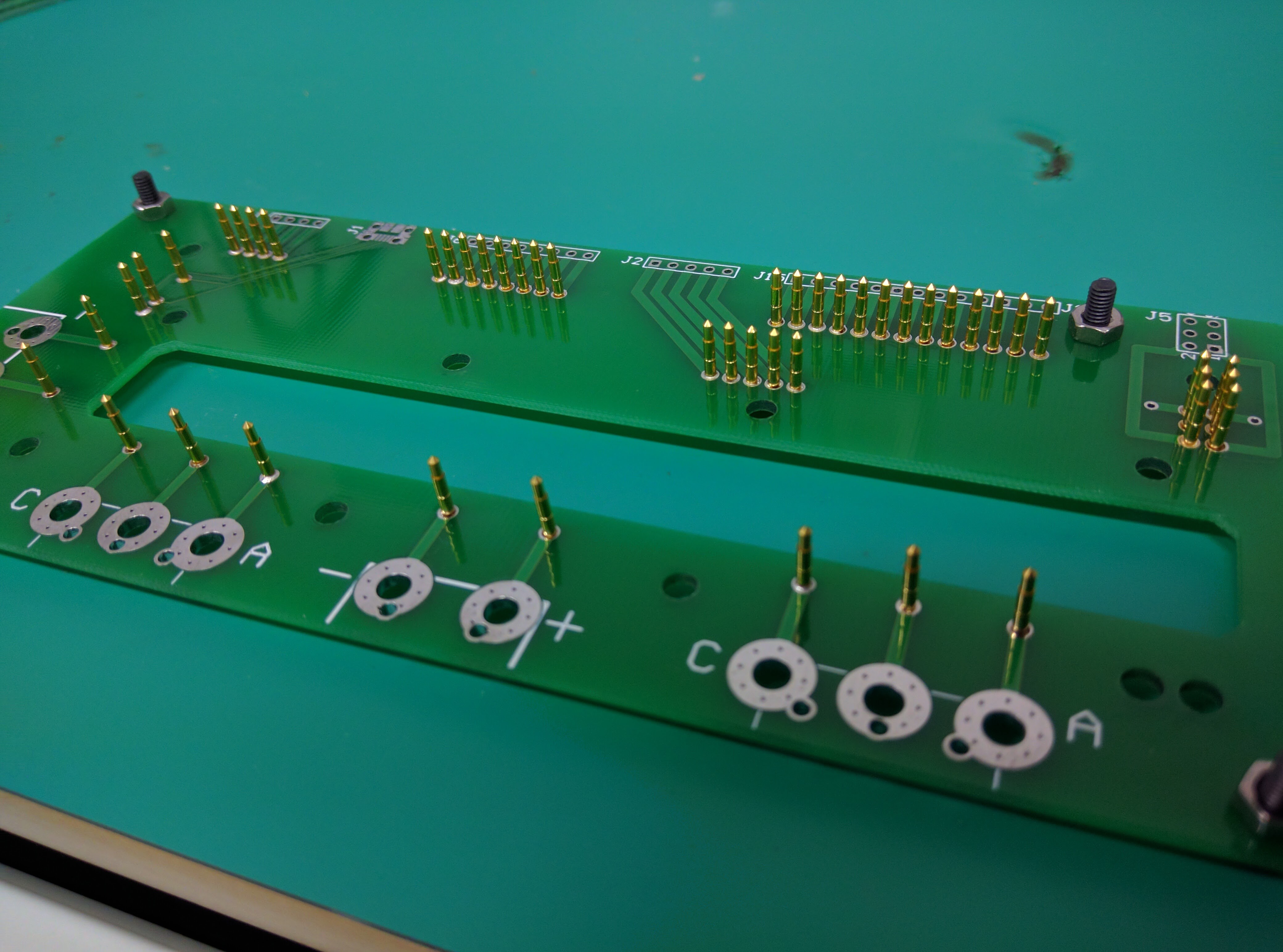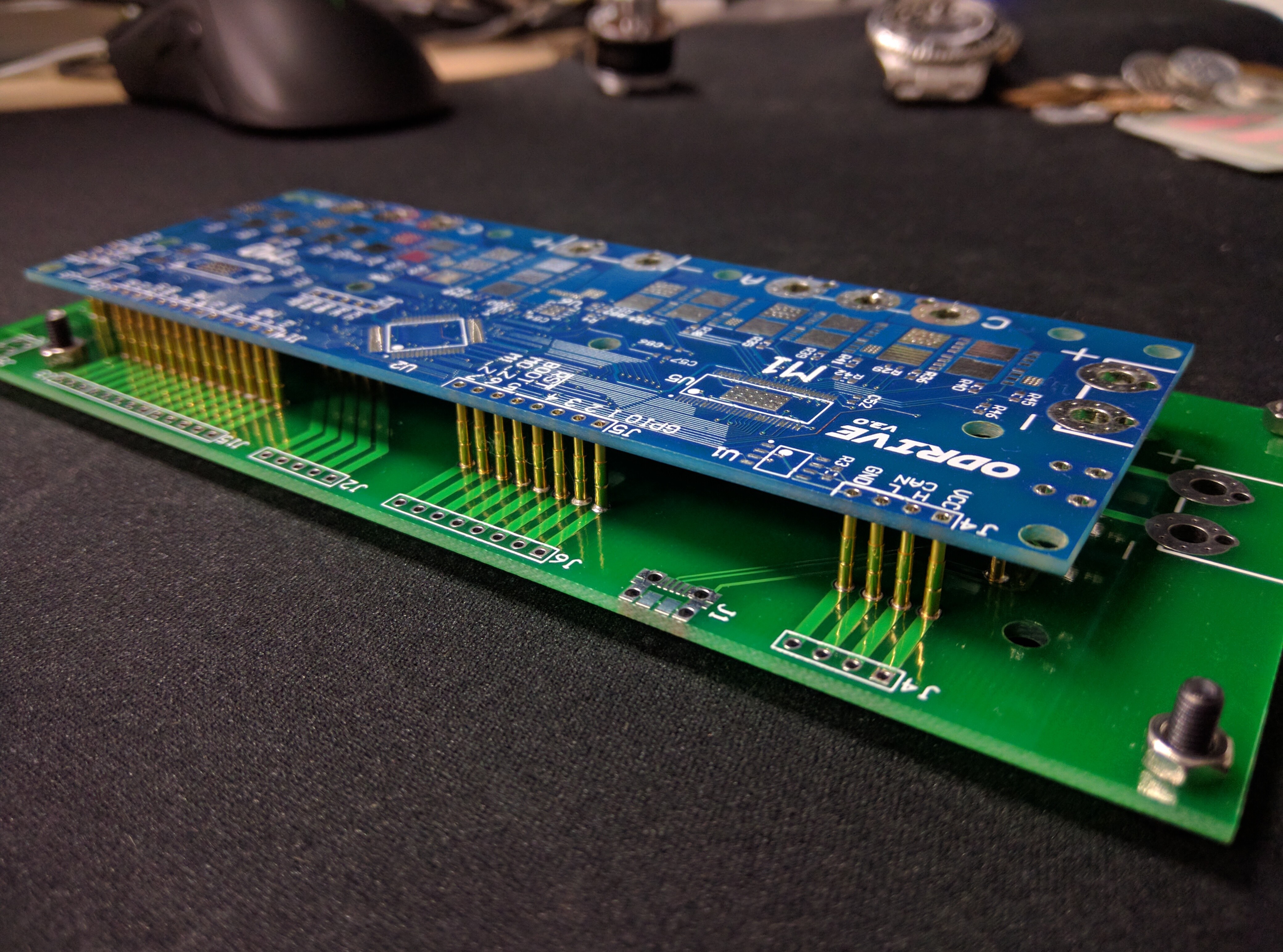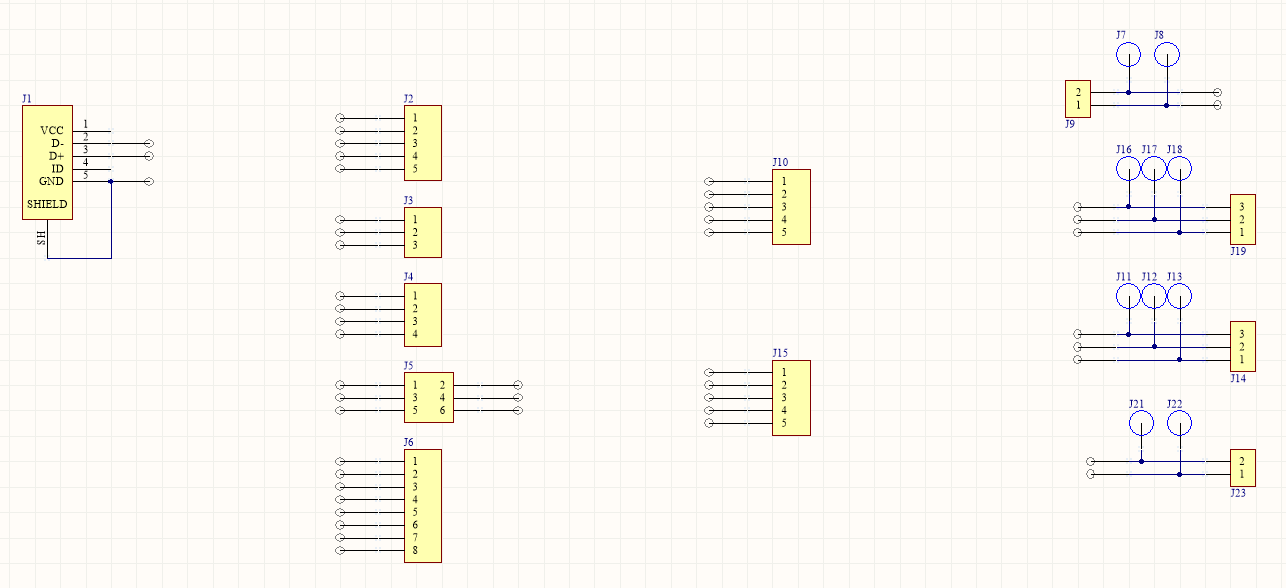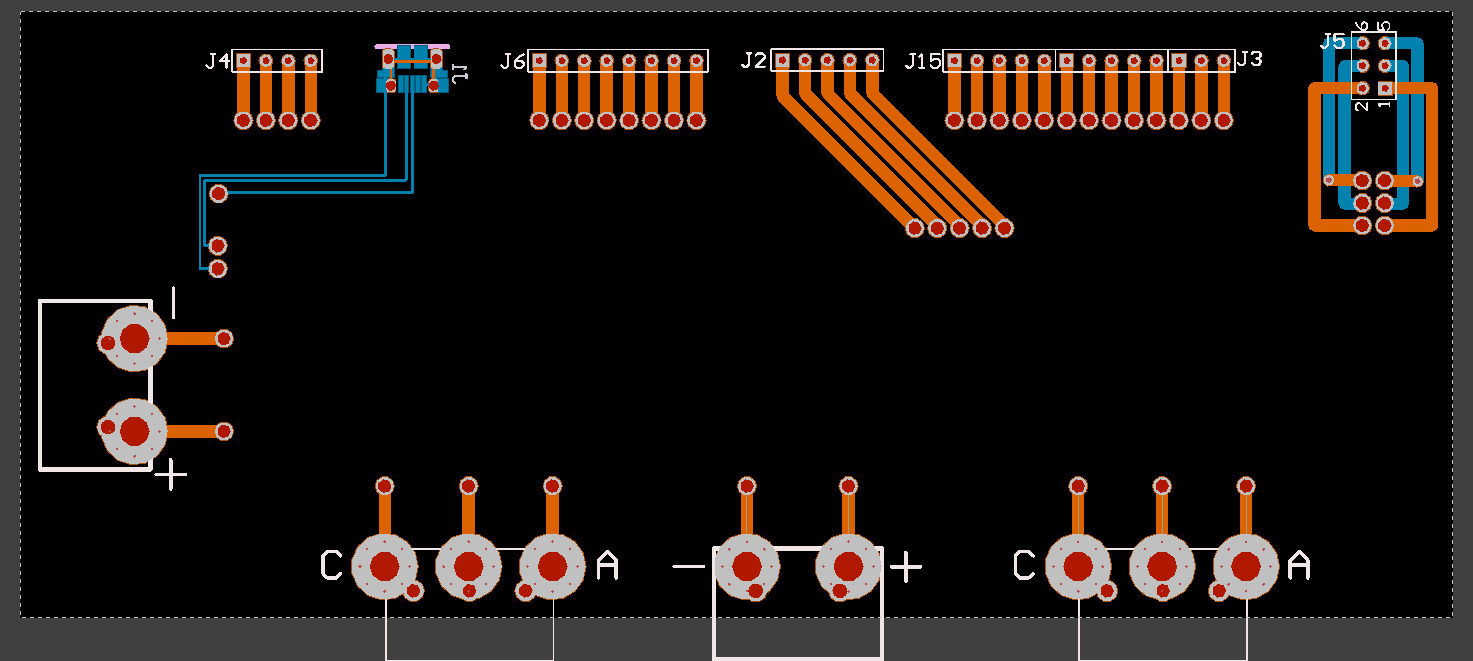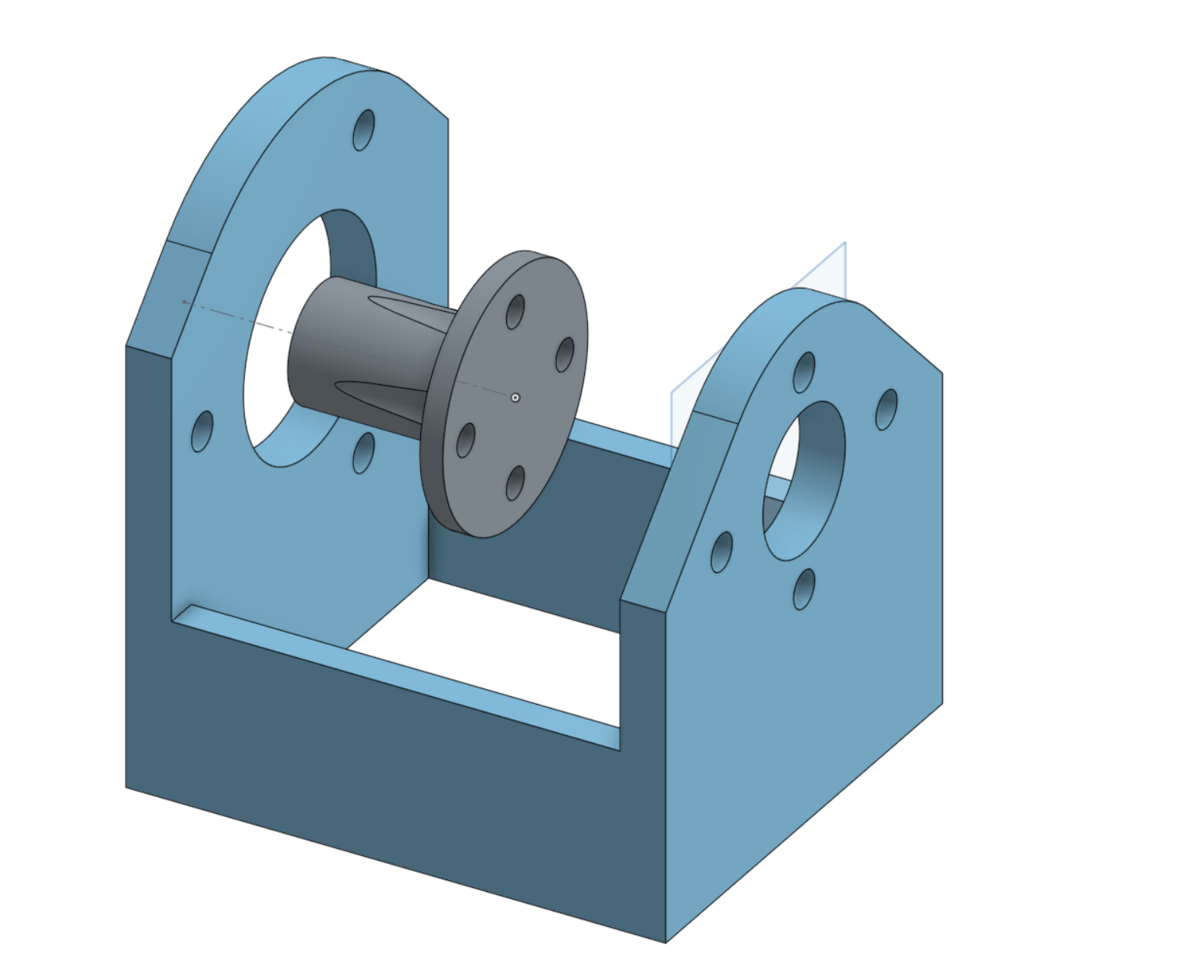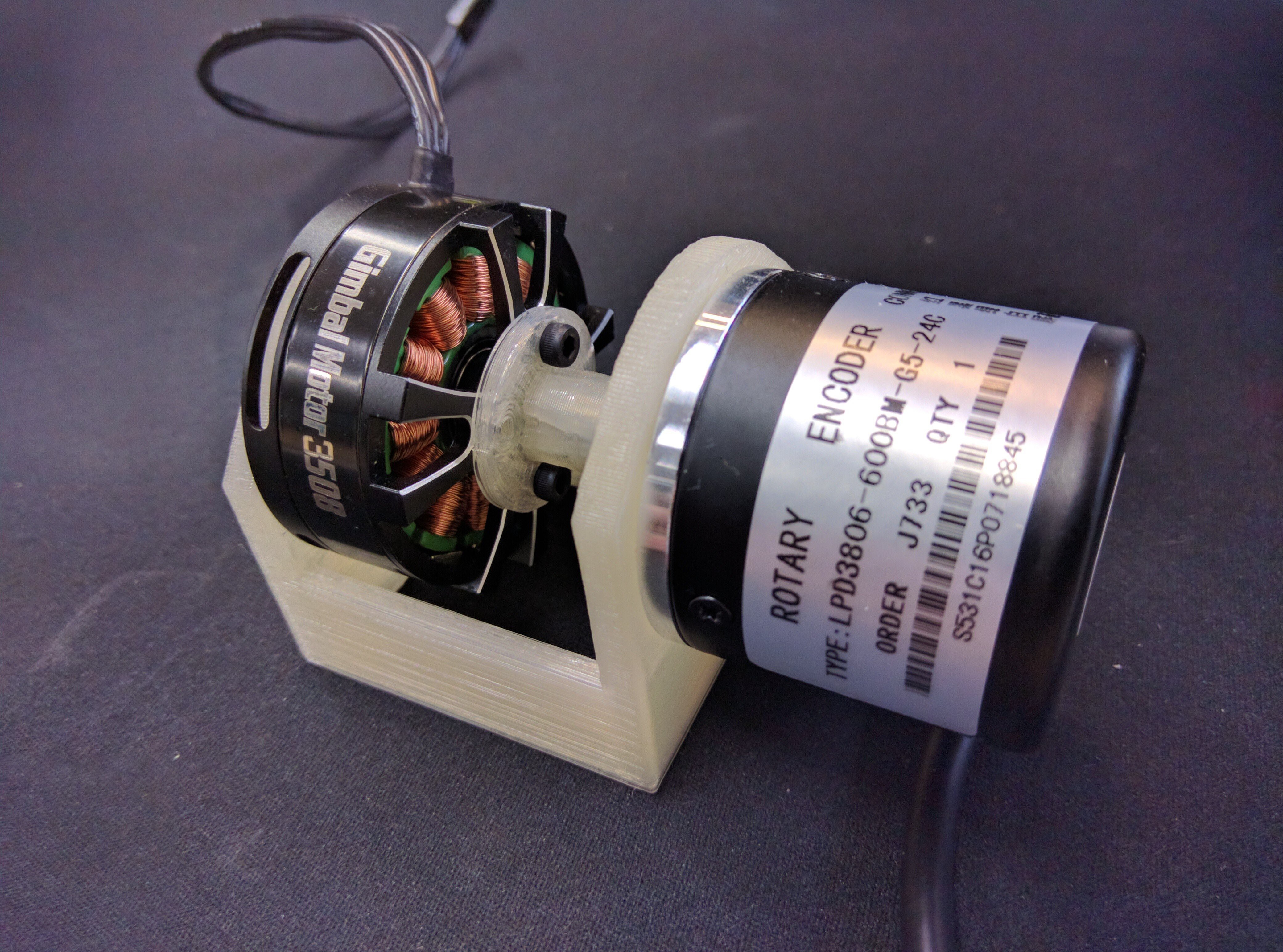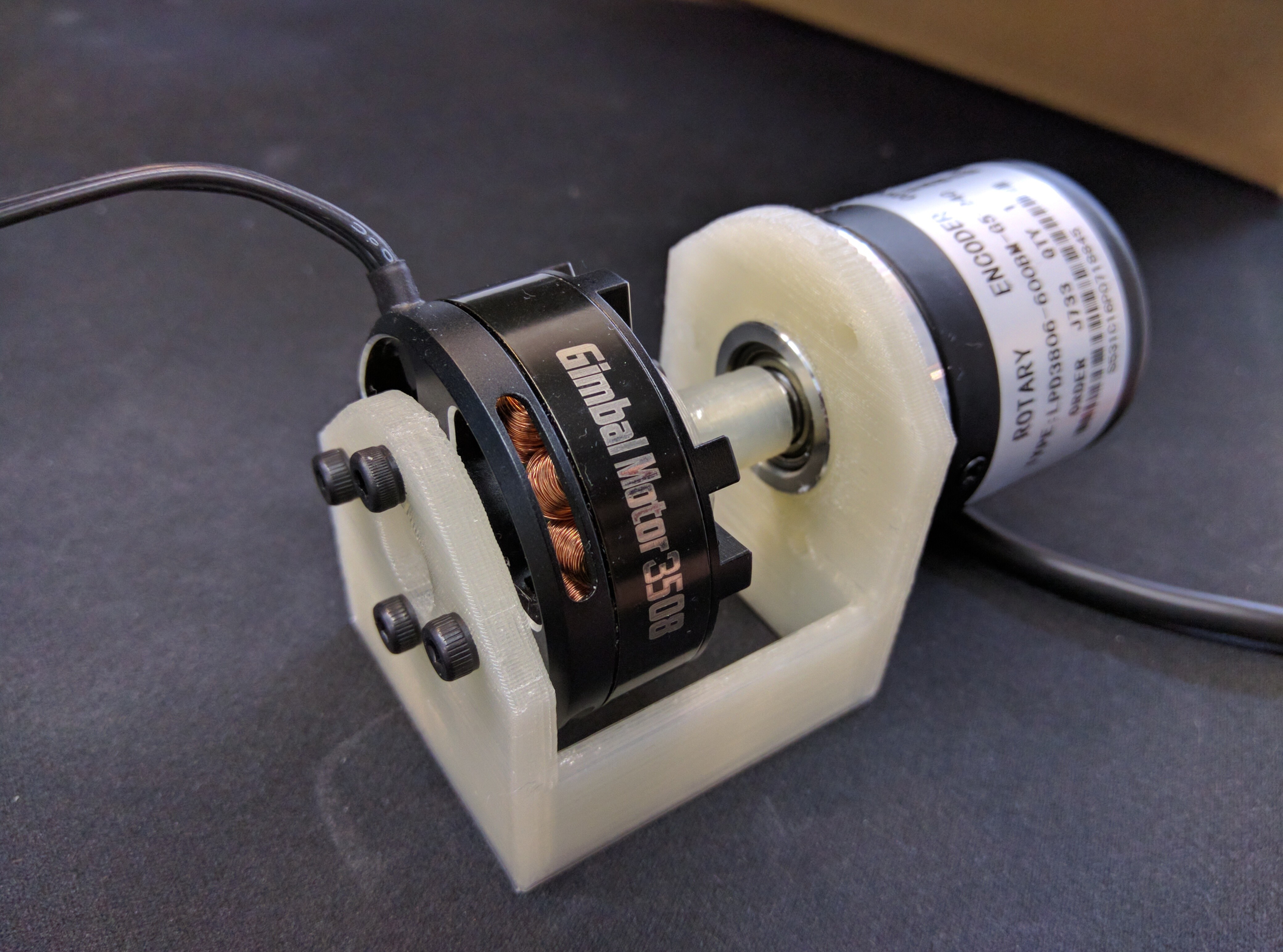-
ODrive v3.2 and Alpha Release
03/27/2017 at 20:31 • 2 commentsI am excited to let you know that the time has finally come for the alpha stage of the ODrive project. This consists of two components, the alpha software release and the manufacturing run for ODrive v3.2.
TL;DR: Get your v3.2 alpha board Here.
ODrive v3.2
The new design is ready, and can be reviewed here. The design will go to production on Monday the 17th of April. As a one man team, I would greatly appreciate any and all feedback in from your review. Feel free to leave comments on this post, or write a private message.
Changes from v3.1
- Fix current sensor filter capacitor values
- Break out the SPI port
- Consolidate all 0.1" headers into two long rows
- Remove the confusing EV (Encoder Voltage) rail.
- Add test-points for most interesting analogue signals
- Add precision LDO for AVCC (analog VCC)
- Change MOSFETs to a slightly better Rdson version (30% better)
- Adjust heatsink holes
- Add fiducials
- Improve labling
ODrive v3.2 production run
You can buy a board in this run on the shop: https://odrive.xyz/shop. The expected shipping date is expected to be the 15th of May, and the pre-orders will close on Monday the 17th of April, though some extra stock may be left after that. This is the board revision designed to be delivered simultaneous to the alpha firmware release.
Firmware alpha release
You can check which features will be included in the release here. The alpha release will include all the core features of the board, and allow go-to commands sent over USB, as well as step/direction interfacing.
Proper documentation, setup and tuning instructions will be ready for you by the time that the board ships.
ODrive is for real
As I mentioned in the previous post, I finish my day job on Friday, and I will be taking up developing ODrive full time.
ODrive is a serious product and deserves a website, so I bought the domain odrive.xyz, and set up a Squarespace website. As of the time of writing, I have only added the shop page: the reason for putting up that first is to be able to take the payments for this v3.2 pre-order. I've been focusing on getting the v3.2 board ready, and I haven't had time to put the rest up just yet. It will be up soon :)
The reason I'm sharing this with you now, is because some people astutely pointed out that a website with no content, and only a shop page, looks very suspicious. Rest assured that the site at odrive.xyz is mine, and communication from oskar.weigl@odrive.xyz is legitimate. Any payments should go to ODrive SWE, and the address of the business is in Stockholm, Sweden. The VAT number of the business is SE901114035801.
ODrive forums
I am deeply impressed with the projects, ideas, skills and contributions that all of you have conveyed to me through various channels. I am really excited to talk to you about your application, how we can build the ODrive community and advance the project. In the next couple of weeks, I will set up an online forum for ODrive, and I hope you will join the community there!
This will be the place for all kinds of discussions, comments, ideas, feature requests and queries. It will also serve as the main place to get help with your ODrive; where I, and others who will be gaining experience with the board, can all help you and each other. We'd also love to hear about your project: what you wish to do when kilowatts and micrometers meet in an affordable package.
-
Someone please build a parallel cable robot
03/23/2017 at 11:44 • 7 commentsI think the ODrive could provide plenty of power to make some really cool high dynamics.
I was inspired by the Hangprinter discussions over on the RepRap forums.
-
Progress Update
03/10/2017 at 01:48 • 6 commentsIt's time for an update.
There has been some significant progress on the software including two major new features. The v3.1 hardware that I wrote about in the previous post has been further tested, this time not only by myself, but by several early developers. We managed to find only one serious hardware bug so far, which is fixed by replacing four capacitors. With the fixes to those bugs, the alpha testing stage is around the corner.
New Features
Two new major features are ready: USB Serial and brake resistor control.
USB CDC - The main way for the ODrive to communicate with a PC or embedded computer (such as the RaspberryPI) is via USB Serial (aka USB CDC). This interface will be used both for sending configuration and commissioning commands, and interfacing with existing tools that have G-Code style output. With further extension, it can also support binary, and various application specific, protocols. Yay for open source.![]()
With significant help and contribution from @nickaknudson we now have a working USB CDC interface, which runs in a task parallel to the motor control tasks. The current implementation is very basic, it parses the commands and relays position commands directly to the motor control task. Going forward we will add trajectory generation to support coherent movement between multiple axes. Then we can handle the basic G0 and G1 G-Code "go-to" commands.![]()
Brake resistor - Software support for a brake resistor is now in place. This means that we can safely dissipate the energy absorbed when decelerating. This is important since many power supplies cannot handle reverse energy flow. The implementation has the two motor controllers estimate their power draw, and then calculates the net power draw from the power rail. If it is negative in total, the pulse width of the brake resistor control is set to exactly dissipate and hence cancel this power.
Demo - In the above video you can see a demo of both features.
Hardware bug found
Everyone knows that voltage amplifiers have high input impedance, and low output impedance. Right? Well, apparently not.
![]()
Above is a figure from the DRV8301 datasheet. 100 ohm output impedance doesn't qualify as low output impedance in my book... So this extra output impedance is causing a way too large "R" in the RC filter that filters the current sensor output. Hence the current sensing is way too slow, and barely usable.
![]()
The fix involves replacing the capacitors highlighted in green painted labels with 2.2nF capacitors.
![]()
Replacing 0603 capacitors on lots of boards gets quite tedious. Nevertheless, I don't want to ship out any of the remaining ODrive 3.1 boards with known errors on them. As you can see, I have 8 left, and they should all work now. If you are interested in claiming one of them, sign up for an Initial Development board on this form.
Crowdsourced Testing
I'm incredibly grateful for the people who were brave enough to pay for a board that was completely untested and with missing core features, and generous to spend their time helping to test those features as the were being brought up. You know who you are: Thank you!
Below are some videos of some ODrives out there ;D
ODrive v3.2 and Alpha Testing![]()
Already almost 200 of you have signed up for a board and at the same time shared with me the amazingly diverse projects that you want to use ODrive for. There were many projects that I expected like 3D printers, CNC mills, and Pick and Place machines. However there were so many cool and diverse projects I didn't expect. Here are some examples that was mentioned by more than one person each:
- polargraphs
- robot arms
- walking robots
- exosuits
- motion simulation platform
- heavy duty camera gimbals
- camera dolly/slide
- under water robots
- mobile ground robots
- various art projects
I aim to have a quote ready for the manufacture of ODrive v3.2 at the beginning of April, and with that, I will open pre-orders for the Alpha release. I will send an email to everyone signed up on the google form. It will also be possible for anyone else who wants to join in during the couple of weeks that the pre-order is open, before manufacturing starts.
Full Throttle
The project is gaining momentum. With the fantastic response from the community, I am motivated to spend more time on this. In April, I will quit my current job, and I will be able to work on ODrive full time. This should lead to approximately a factor 8 increase in my contribution rate.
Lets do this!
-
The Boards Have Arrived!
01/20/2017 at 17:39 • 4 commentsCheck this out, a box full of goodies:
![]()
Inside each of the 5 packets, are 6 ODrive v3.1. And they are in lovely black and gold. The manufacturing quality of CircuitHub is really top notch ;D
![]()
Here is a picture of the new boards on the testbed. Actually I never used the test bed in the end, since the manufacturing quality was so good. I don't expect any defects, and with such a small batch I don't mind replacing a board if it was indeed a DoA.
![]()
ODrive v3.0 next to v3.1. Black looks great ;D
![]()
Preparing some kits to go out with the first round of pre-alpha board orders.
![]()
With the help of the early developers who will be helping, hopefully Alpha release will occur soon. If you want to get notified when that happens, make sure to sign up for the board manufacturing run: Link.
-
Sexy machine assembly
12/24/2016 at 04:13 • 1 commentIn my previous post I mentioned that the first batch of ODrive v3 is being assembled. I asked CircuitHub to take a video. And holy shit, industrial pick and place machines are so sexy! Hopefully ODrive will enable inexpensive machines that go this fast ;D
![]()
![]()
-
Two motor operation
12/14/2016 at 18:37 • 0 commentsTwo motor operation is finally done. For those of you who are interested, here is the interrupt-dance that makes it all work: Link.
Cheers!
-
Prototype manufacturing run!
12/03/2016 at 09:51 • 9 comments![]()
The time has finally come for the manufacturing run of ODrive v3.1. They are now on the way, and should arrive early to mid January.
At this stage, around 20 board kits are going out the people who signed up to the "Inital development" phase.
Since the boars are going out to just a small group of early developers, I will have the time to personally get you up to speed with the codebase and help to get going with the hardware. Then, together, we can prepare some stuff that is a bit more stable and a bit more documented for when the alpha testing begins.
The cost for me to get this small batch of boards manufactured was $96 per board, so that is the amount I need to ask for a kit, plus shipping.
The kit involves basically everything seen in the above picture, and consists of:
- ODrive v3.1
- USB Programmer
- A set of the optional large gauge wire screw terminals
- A set of pin headers
- Some nylon standoffs
I hope that ODrive will be able to help you make an awesome robotics project, thank you so much for your contribution to helping people have access to open robotics hardware and software.
-
Testing: Progress update
11/26/2016 at 15:28 • 1 commentI mentioned in a Previous post that before we can start manufacture, we need to have some basic functionality tests to preform QA testing. For a couple of months I was unable to work on this project, but now I am back to being able to spend most of my weekends again. So I have been able to make some progress.
Currently the following is ready:
- Testing rig with a motor and encoder
- Testing PCB with pogo pins to make quick connections during testing
- Low level code to trigger current sensing and motor control from the 3-phase PWM pheriperal
- Online current sensor calibration
- Lock-in, open-loop voltage vector motor spinning
- Automatic motor resistance measurement
The following is still left to be done before manufacturing can commence:
- Test that the bed-of-nails board makes good electrical contact
- Check that the transient response of the current sensing is good
- Low level code to allow hand-over of the ADCs between the two motor channels
- Write the encoder drivers
- Finish up the test routines to be able to detect faults
Pictures and video!
Below is a motor-encoder pair doing lock-in, open-loop voltage vector motor spinning.
New motor test cradle. The design is openly available, Link.
![]()
Some pictures of the bed-of-nails. The design is openly available, Link.
![]()
![]()
-
Production testing: Hardware
08/20/2016 at 05:52 • 0 commentsIn order to finish manufacturing of the first batch of v3 boards, we need a simple way to test if the boards work as they come off the automated assembly. Since I want to get the boards out to people as soon as possible, I will only test the very basic functionality. More features can be added to the tests later.
The basic functionality I want to test is:
- Does the logic supply power up?
- Does the firmware boot up?
- Execute some simple test voltage vectors to test the current sensors.
- Spin a motor open loop (no encoder feedback)
- Does the encoder work?
- Spin the motor closed loop.
- Same tests on the 2nd motor channel.
This requires two main components: the test hardware and the test software. In this post I will only focus on the test hardware.
Test board
To quickly test the board, one of the best ways is to make a bed-of-nails that can make connection to all the required places on the board for testing all in one go. The idea is to use spring-loaded pins like these pogo pins that sit on a separate PCB underneath that can break out the connections to the test equipment. @Thomas Branch made one on Circuit Maker here. At the time of writing the design is not completely finished reviewing yet, but should be done soon.
Here are some picutres:
Encoder - motor rig
To do the aforementioned motor tests, we need a motor and an encoder for each channel. The setup is designed to be as simple as possible, so it is just a motor directly coupled to an encoder, nothing else. I picked this gimbal motor since I just happened to have it lying around. But I picked a gimbal motor in particular since its high phase resistance means that if there are any bugs that cause the voltage to be switched on much higher than intended, it means that it doesn't just blow up immediatly, just melts slowly (;
I picked this encoder. You can find the design on onshape. Below are some pictures:
![]()
![]()
![]()
-
Boards and Development
06/26/2016 at 22:01 • 13 commentsBoards!
The number one thing people have asked me is: "When are the boards available?". It took a while to get ready, but I am now happy to announce that the release candidate of board version 3.1 is ready! You can review this release candidate in any of the following ways:
- You can review the original Altium Designer files in the on GitHub.
- You can review the schematic and the BOM.
- I converted the AD design to the free tool CircuitMaker. Check it out here.
I am not sure if the continued development will be with the AD files in GitHub, or on CM, it depends on the input I receive from the community.
After identifying and working around some bugs present in v3.0, I was able to verify that the basics of the board design does indeed work as expected. In v3.1, I have fixed the bugs that were present in v3.0, and made some minor modifications. I have refrained from any major modifications or improvements to make sure that the changes that were applied should only fix the issues, and not introduce any new ones. Therefore, I am fairly confident that once this version is released, that it should be fine to distribute the first batch of development prototypes.
Board production runs
So while the design is open source, and anyone is free to go and make boards, I realise that the majority of us would prefer to just buy an assembled board. So I will facilitate some board manufacture production runs. I realise that some people want to get their hands on a board at the early alpha stage, while some want to reduce the risk and want to join in when the project is ready for beta release.
To that end, I have prepared this survey:
CLICK HERE TO SIGN UP FOR A BOARD!
Roadmap of features
To help decide when you would want to join the project, or what ODrive can do for you at what time, it makes sense to have a roadmap of features. You can see the first draft of the roadmap of features we want to get into the first usable release of ODrive. The milestones to look out for in particular are First usable release, and Alpha testing production run. When these are done is basically when the alpha production will happen.
This roadmap is intended to be dynamic, and will change with feedback from the community, and new ideas come about. Your input to this roadmap is very welcome!
How you can contribute
Have a look at the roadmap. If you feel that have the skills to implement any of the features we want to include in ODrive, then please join the development effort and help make them become a reality! If you have an idea, or made a feature on your own, just get in touch, and we can get it in the roadmap, or get the feature merged.
ODrive - High performance motor control
Hobby brushless motors are incredibly cheap and powerful. However we need a way to make robots out of them. ODrive is that way.
 Oskar Weigl
Oskar Weigl